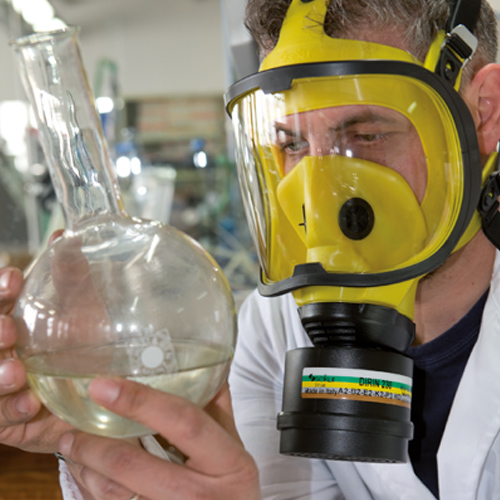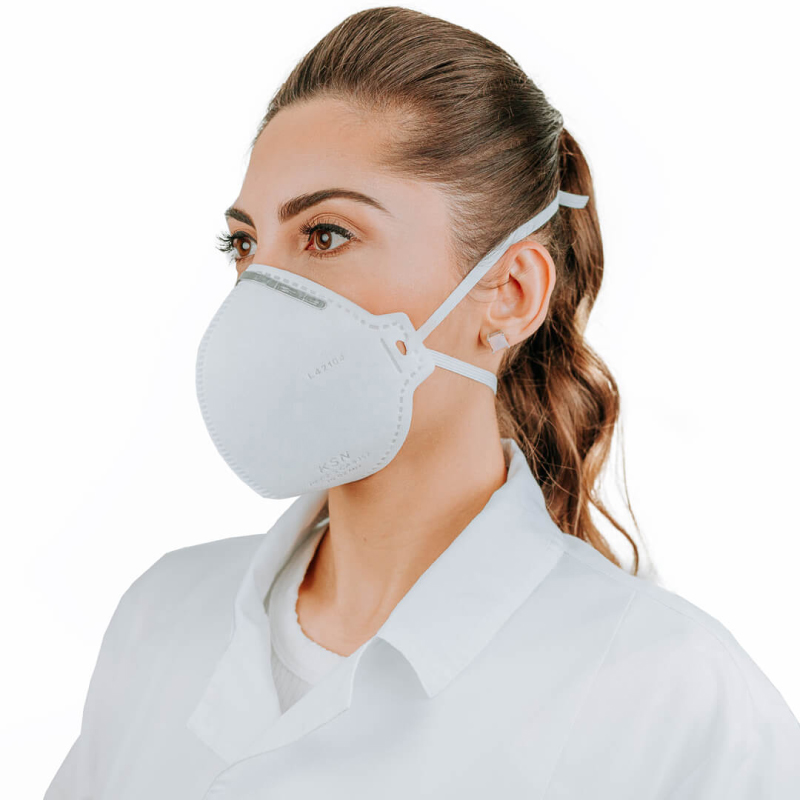Dust Masks, Filtering Facepieces, Respirators: What's What and Who's Who?
You walk into the wood shop and are standing by the table saw while Bob, the carpenter, is getting ready to cut some boards. "You might want to put this dust mask on," says Bob as he hands you a paper mask with two straps.

Dust Masks, Filtering Facepieces, Respirators: What's What and Who's Who? en
22/12/2022
Having it figured out will help your workers breathe easier.
You walk into the wood shop and are standing by the table saw while Bob, the carpenter, is getting ready to cut some boards. "You might want to put this dust mask on," says Bob as he hands you a paper mask with two straps.
You've never used one before but take it anyway, hold the pointed end under your chin, and cover your nose with the wide end of the mask while you watch the wood being cut. You notice that Bob's mask is the reverse of yours, and he's using the two straps to hold his mask in place.
Considering this scenario, questions you might ask include: What are the requirements for when to use a respirator, who can wear a respirator, and what do you need to do if employees have to wear respirators?
Definitions
OSHA's regulations on respiratory protection, 29 CFR 1910.134, 1 call a half face dust mask that's made of paper a "filtering facepiece" because the entire facepiece is a filter. A half or full face respirator that is made of rubber or plastic is known as a "tight-fitting covering" respirator.
Because Bob offered you a respirator when you walked into the shop, do you think Bob's training was effective?
Most filtering facepieces sold are of the N95 variety. Under the NIOSH scheme (42 CFR Part 84)2 of identifying filters, N means "not resistant to oil" particulates. The other two respirator designations are P, meaning "oil proof," and R, meaning "resistant to oil" particles.3
The 95 means this mask will filter out 95 percent of particles that are 0.3 microns in diameter or larger. The other designations are 99 and 100--filtering out 99 percent and 99.97 percent of particles that are 0.3 microns in diameter or larger, respectively.2
Thus, our filtering facepiece N95 is a disposable, paper respirator that is not resistant to oil and will filter out 95 percent of the particles 0.3 microns or larger.
The tight-fitting respirator is designed to be reused and can be used to protect the wearer from a variety of environmental conditions, depending upon the type of cartridge or filter used. For purposes of this article, we are going to limit our discussion to particulate matter.
When Should We Use One vs. the Other?
Let's get back to the wood shop. First of all, we are visitors and, as such, probably shouldn't even be in the shop unless we have received an orientation or some training so that we understand the hazards we may encounter there. Are we wearing steel-toed shoes? What about safety glasses? And that respirator--should we have accepted it from Bob if we didn't know what to do with it? Should he even have offered it to us?
OSHA says in 1910.134(c)(2)(ii), "the employer must establish and implement those elements of a written respiratory protection program necessary to ensure that any employee using a respirator voluntarily is medically able to use that respirator, and that the respirator is cleaned, stored, and maintained so that its use does not present a health hazard to the user. Exception: Employers are not required to include in a written respiratory protection program those employees whose only use of respirators involves the voluntary use of filtering facepieces (dust masks)."
Bob's company needs to look at its use of respirators. If Bob needs only to voluntarily use a respirator, then it does not have to include him in the program, as the above regulation states. However, the company says Bob is required to wear a respirator and thus has to get medically cleared to before he is allowed to wear a respirator.
The company has to determine what chemicals its employees are exposed to and at what concentrations. This is part of the hazard assessment that is required by 29 CR 1910.132(d). This hazard assessment will help the company ensure that the correct respirator and filter or cartridge are selected. Part of the hazard assessment should look at what types of engineering controls can be implemented so the employees do not have to use personal protective equipment.
The written respiratory program has to include the nine components that are listed in 29 CFR 1910.134(c)(1):
- Procedures for selecting respirators for use in the workplace;
- Medical evaluations of employees required to use respirators;
- Fit testing procedures for tight-fitting respirators;
- Procedures for proper use of respirators in routine and reasonably foreseeable emergency situations;
- Procedures and schedules for cleaning, disinfecting, storing, inspecting, repairing, discarding, and otherwise maintaining respirators;
- Procedures to ensure adequate air quality, quantity, and flow of breathing air for atmosphere-supplying respirators;
- Training of employees in the respiratory hazards to which they are potentially exposed during routine and emergency situations;
- Training of employees in the proper use of respirators, including putting on and removing them, any limitations on their use, and their maintenance; and
- Procedures for regularly evaluating the effectiveness of the program.
Bob has to find out whether he is medically qualified to wear a respirator.4 When he goes to the physician (or other licensed health care professional), he needs to bring several things with him: a copy of the company's respiratory protection program, a copy of 29 CFR 1910.134, a copy of Bob's job description, and a completed copy of Appendix C, the medical questionnaire (unless the examination covers and obtains this information).
With negative-pressure masks, getting a good facepiece-to-face seal is imperative.
Once there, it is the doctor's prerogative as to how the examination will be conducted and whether it will include a chest X-ray, a pulmonary function test, or even an EKG.5
Bob completes the questionnaire, submits to the doctor's examination, and is found to be qualified to wear a respirator. However, we are not yet finished with Bob.
What Else?
Bob needs training to understand how to use, inspect, put on, remove, and maintain the respirator. He has to know why it is necessary, its limitations and capabilities, and its use in an emergency. He also has to be able to recognize medical signs and symptoms that could limit its use or effectiveness, and he needs to know about the regulations.6 The training has to be understandable to Bob, and his company has to show that the training is effective.
Because Bob offered you a respirator when you walked into the shop, do you think Bob's training was effective?
Finally, Bob needs to be fit tested to ensure the respirator he will be using will fit him correctly. The filtering facepieces that Bob uses are negative-pressure masks. When Bob inhales, he is pulling air through the filter media and then into his lungs. If the mask doesn't fit him correctly, as he inhales, he will be pulling contaminated air in between the mask and his skin.
With negative-pressure masks, getting this good facepiece-to-face seal is imperative. A day's growth of beard or even reusing a disposable respirator can cause Bob to fail his fit test.7
Are We Done Yet?
Some people would answer YES, and they are correct. Why? We have developed our written respiratory program. We have given our employee his medical examination, his training, and fit testing. He is medically qualified to wear a respirator and has a respirator that fits him. We discussed with him the fact that he shouldn't have given you a respirator.
Some people would say NO, and they also would be correct. Why? Because Bob is working with wood dust. NIOSH and ACGIH consider that wood dust is an occupational carcinogen. "NIOSH recommended exposure limits . . . based on risk evaluations using human or animal health effects data, and on an assessment of what levels can be feasibly achieved by engineering controls and measured by analytical techniques."8 This we haven't done.
Regardless whether you are in the yes camp or the no camp, all of these steps are necessary when setting up your respiratory protection program.
Source: OH&S



